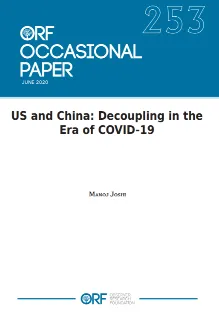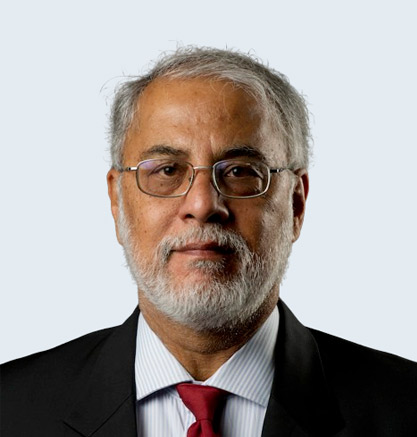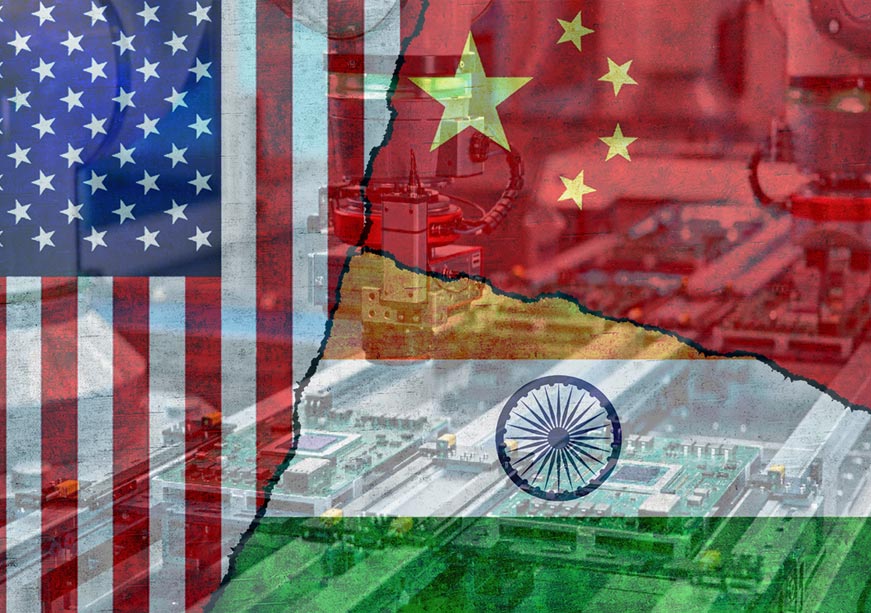[a] ‘Decoupling’ is the deliberate dismantling of cross-border supply chains that were a key feature of globalisation.
[b] The largest beneficiaries of this pattern were mostly in Asia, and mainly Vietnam, Taiwan and Thailand; Mexico was the main beneficiary outside Asia.
[c] In this system raw materials, goods, assemblies and subassemblies are received “just in time” to align with the production schedule of a product. This increases efficiency, and reduces inventory costs.
[d] Especially technology provided by the giants like Apple, Cisco, Google, IBM, Intel, Microsoft, Oracle and Qualcomm.
[e] This means that notwithstanding anecdotal evidence of firms relocating from China, thousands of other foreign firms were being set up in China every month, in addition to the tens of thousands that were already there.
[f] This targets the IT industry, high-end CNC machines, aerospace and ocean engineering equipment, high-end vessels, rail transportation, energy saving and new energy vehicles, electrical equipment farming machines, new materials, biomedicine and high-end medical equipment.
[g] This could be done through economic and tax incentives, or the invocation of the Defence Production Act or the International Emergency Economic Powers Act which can mandate some decisions to the private businesses in the name of national security.
[h] Besides providing for the “survival needs” resulting from the crisis, it also pushed through a series of reforms in industry and agriculture that have been outstanding for some time.
[1] Yanuz Aslan et als ed “How has globalization affected emerging market economies,” BIS Background Paper in “Globalisation and deglobalisation,” BIS Papers No 100 December 2018 (Monetary and Economic Department, Bank of International Settlements, Basel, 2018) pp 43-4
[2] Ibid.
[3] “A quick guide to the US-China trade war”, BBC News, January 16, 2020, Accessed on June 3, 2020
[4] “Trade in goods with China”, United States Census Bureau, Accessed on May 3, 2020
[5] European Chamber of Commerce in China, “China Manufacturing 2025: Putting Industrial Policy ahead of market forces”, March 2017, p. 2, accessed on May 3, 2020
[6] “Supply Chain Graphic of the Week: China’s dominance of many US import categories,” Supply Chain Digest, June 19, 2019, http://www.scdigest.com/ontarget/19-06-19-12.php?cid=15591, accessed on May 5, 2020
[7] For more on this see, Manoj Joshi, “Invest, Acquire, Dominate: The rise and rise of China tech,” ORF Occasional Paper No 223, November 11, 2019, https://www.orfonline.org/research/invest-acquire-dominate-the-rise-and-rise-of-china-tech/
[8] Andrew Jacobs, “China softens tone in Japan dispute,” New York Times, September 28, 2010, https://www.nytimes.com/2010/09/29/world/asia/29chinajapan.html?, Accessed on June 3, 2020
[9] Yuko Inoue, “China lifts rare earth export ban to Japan: trader,” Reuters, September 29, 2010, https://www.reuters.com/article/us-japan-china-export-idUSTRE68S0BT20100929, accessed on May 15, 2020
[10] “Supply chains for different industries are fragmenting in different ways,” The Economist, July 11, 2019, Special Report on Global Supply Chains, https://www.economist.com/special-report/2019/07/11/supply-chains-for-different-industries-are-fragmenting-in-different-ways, Accessed on April 9 2020
[11] Ibid.
[12] Nomura Global Markets Research, “Trade tensions: a look at the bottom up evidence,” Asia Insights, September 4, 2019. This is a small sample and does not address the importance of China’s large domestic consumption market.
[13] William Alan Reinsch et al., eds, “The Impact of Rules of Origin on Supply Chains: USMCA’s auto rules as a case study,” A Report of the CSIS Scholl Chair of International Business, April 2019 (Center for Strategic and International Studies) – Executive Summary, https://www.wita.org/wp-content/uploads/2019/04/190403_Scholl_RulesofOrigin_WEB_v3.pdf, accessed on May 12, 2020
[14] “Trade war spurs sharp reversal in 2019 Reshoring Index, foreshadowing COVID-19 test of supply chain resilience,” Kearney [April 2020], https://www.kearney.com/operations-performance-transformation/us-reshoring-index/full-report, accessed on May 12, 2020
[15] Jane Perlez, “US allies see Trans-Pacific Partnership as a check on China,” New York Times, October 6, 2015, https://www.nytimes.com/2015/10/07/world/asia/trans-pacific-partnership-china-australia.html, accessed on May 13, 2020
[16] “Trump has attacked China this week accusing it of ‘one of the greatest thefts in world history’ but what is behind his attacks,” South China Morning Post, August 27, 2015, https://www.scmp.com/news/china/policies-politics/article/1853069/trump-has-attacked-china-week-accusing-it-one-greatest, accessed on May 13, 2020
[17] State Council of the People’s Republic of China, “Outline of the National Medium- and Long-Term Science and Technology Development Plan 2006-2020, http://www.gov.cn/jrzg/2006-02/09/content_183787.htm, (Translated by Google), accessed on May 16, 2020
[18] James McGregor, “China’s drive for ‘indigenous innovation’: a web of industrial policies,” US Chamber of Commerce (nd, np), https://www.uschamber.com/sites/default/files/documents/files/100728chinareport_0_0.pdf, accessed on May 16, 2020
[19] Jakob Hanke Vela, “Coronavirus won’t kill globalization, but will clip its wings,” Politico, April 23, 2020, https://www.politico.eu/article/coronavirus-wont-kill-globalization-but-will-clip-its-wings/, accessed on May 16, 2020
[20] Julian Baird Gerwitz, “China’s Long March to Technological Supremacy: The roots of Xi Jinping’s ambition to ‘catch up and surpass’,” Foreign Affairs, August 27, 2019, https://www.foreignaffairs.com/articles/china/2019-08-27/chinas-long-march-technological-supremacy, accessed on May 14, 2020
[21] Manoj Joshi, “Invest, Acquire, Dominate….” 13-14
[22] Ibid.
[23] Ewen MacAskill and Dominic Rushe, “Snowden document reveals key role of companies in NSA data collection,” The Guardian, November 1, 2013, https://www.theguardian.com/world/2013/nov/01/nsa-data-collection-tech-firms, accessed on May 23, 2020
[24] Raymond Zhong and Paul Mozur, “For the US and China, a technology Cold War that’s freezing over,” New York Times, March 23, 2018, https://www.nytimes.com/2018/03/23/technology/trump-china-tariffs-tech-cold-war.html, accessed on April 25, 2020
[25] Anjani Trivedi, “China to the World: We don’t need your factories anymore,” Wall Street Journal, October 18, 2018, https://www.wsj.com/articles/chinese-manufacturers-once-needed-overseas-suppliersnot-any-more-1476801578, accessed on April 4, 2020
[26] James Griffiths, “A Chinese OS at last? More than 40 per cent of Dell PCs in China now running homegrown Windows alternative,” South China Morning Post, September 14, 2015, https://www.scmp.com/tech/china-tech/article/1857948/chinese-os-last-more-40-cent-dell-pcs-china-now-running-homegrown, accessed on May 15, 2020
[27] Ernest Scheyder, “ Exclusive: US seeks to challenge China’s electric-vehicle supply chain dominance,” Reuters, May 2, 2019, https://www.reuters.com/article/us-usa-lithium-electric/exclusive-u-s-legislation-aims-to-thwart-chinas-electric-vehicle-dominance-idUSKCN1S81EO?, accessed on May 16, 2020
[28] Manoj Joshi, “Invest, Acquire, Dominate….” 16-17
[29] China Power, “Is it a risk for America that China holds over $1 trillion in U.S. debt?” Center for Strategic and International Studies (CSIS) China Power Programme, https://chinapower.csis.org/us-debt/, accessed on June 2, 2020
[30] Manoj Joshi, “Invest, Acquire, Dominate…” see section III on “China’s Contentious Leapfrog”
[31] “‘Made in China 2025’ plan issued,” May 19, 2015, http://english.www.gov.cn/policies/latest_releases/2015/05/19/content_281475110703534.htm, accessed on June 9, 2019; Press Notice, The State Council, “New Generation of Artificial Intelligence Development Plan,” State Council Document [2017] No 35, July 8, 2017, https://flia.org/wp-content/uploads/2017/07/A-New-Generation-of-Artificial-Intelligence-Development-Plan-1.pdf, accessed on June 11, 2019
[32] Klaus Schwab, “The Fourth Industrial Revolution: what it means and how to respond,” Foreign Affairs, December 12, 2015, https://www.foreignaffairs.com/articles/2015-12-12/fourth-industrial-revolution, accessed on May 3,2020
[33] See Manoj Joshi, “China and Europe: Trade, technology and competition,” ORF Occasional Paper No 194, May 22, 2019, https://www.orfonline.org/research/china-europe-trade-technology-competition-51115/
[34] For more on this see, Manoj Joshi, “Invest, Acquire, Dominate…”
[35] See Section I: Industry Overview, 2019 Factbook of the Semiconductor Industry Association, https://www.semiconductors.org/wp-content/uploads/2019/05/2019-SIA-Factbook-FINAL.pdf, accessed on May 5, 2020
[36] Stewart Randall, “Silicon: Can China make chips?” Technode, December 4, 2019, https://technode.com/2019/12/04/silicon-can-china-make-chips/?, accessed on May 5, 2020
[37] Meng Jing, “China mutes volume on Thousand Talents Plan as US spy concerns rise but scientists still covet funding,” South China Morning Post, December 8, 2018, https://www.scmp.com/tech/science-research/article/2176897/china-mutes-volume-thousand-talents-plan-us-spy-concerns-rise, accessed on April 20, 2020
[38] “China’s 2019 FDI up 5.8 %, outbound investment falls 6%” Reuters, January 21, 2020, https://www.reuters.com/article/china-economy-fdi/chinas-2019-fdi-up-5-8-outbound-investment-falls-6-idUSB9N28102R#:~:, accessed on June 3, 2020
[39] “China’s post-covid propaganda push,” The Economist, April 16, 2020, https://www.economist.com/china/2020/04/16/chinas-post-covid-propaganda-push, accessed on May 5, 2020
[40] Manoj Joshi, “Coronavirus has made China’s diplomats turn into ‘Wolf Warriors’,” Quint, April 20, 2020, https://www.thequint.com/voices/opinion/china-diplomat-coronavirus-india-foreign-policy-trump-wuhan?, accessed on May 5, 2020
[41] See Pinzhenghe “Its not alarmist to say that the world is isolating China, April 20” in Jordan Schneider’s post, “Two views on US-China relations from China: Don’t Decouple,” Supchina, April 28, 2020, https://supchina.com/2020/04/28/two-views-on-u-s-china-relations-from-china-dont-decouple/?, accessed on May 4, 2020
[42] Shi Zhan, “Be Prepared for the worse,” April 16, 2020, https://mp.weixin.qq.com/s/jP25zmhgsM1pIEt9iYYOtg, accessed on May 4, 2020
[43] Wang Hanfeng, Liu Gang and He Lu, “Will the industry chain be transferred out of China,” CICC Research, May 18, 2020, https://mp.weixin.qq.com/s/FDUM9YAAKsXVbGBUQ5vxOg (Google Translate). Accessed on June 3, 2020. CICC Research is an arm of China International Capital Corporation, one of China’s leading investment banking firms.
[44] Mark Preen, “Economic reform in China: Current progress and future prospects,” China Briefing, April 3, 2019, https://www.china-briefing.com/news/economic-reform-china-opening-up-future-prospects/, accessed on May 1, 2020
[45] Scott Kennedy, “China won’t be scared into choosing marketisation,” CSIS Commentary, April 23, 2020, https://www.csis.org/analysis/china-wont-be-scared-choosing-marketization?, accessed on May 1, 2020
[46] Zoey Zhang, “China’s 2019 Market Access Negative List: What investors need to know,” China Briefing, December 11, 2019, https://www.china-briefing.com/news/chinas-2019-market-access-negative-list-whats-new-attention-investors/, accessed on May 2, 2020
[47] See Maurits Elen’s interview of Alberto Vetoretti partner, Dezan Shira & Associates, “What’s missing in China’s foreign investment law?” The Diplomat, January 22, 2020, https://thediplomat.com/2020/01/whats-missing-in-chinas-foreign-investment-law/, accessed on May 2, 2020
[48] “China didn’t warn public of likely pandemic for 6 key days,” Associated Press, April 15, 2020, https://apnews.com/68a9e1b91de4ffc166acd6012d82c2f9, accessed on April 20, 2020
[49] Junko Horiuchi, “Coronavirus uncertainties deal heavy blow to Japan auto industry,” Kyodo News, March 6, 2020, https://english.kyodonews.net/news/2020/03/d0c9dbf983ca-focus-coronavirus-uncertainties-deal-heavy-blow-to-japan-auto-industry.html, accessed on April 20, 2020
[50] Akira Kawamoto, “Commentary: The great COVID-19 disruption to Asian economies has begun,” Channel News Asia, February 24, 2020, https://www.channelnewsasia.com/news/commentary/covid-19-wuhan-coronavirus-economy-impact-trade-supply-chain-12435728, accessed on April 12, 2020
[51] Leika Kihara, “IMF warns of coronavirus hit to Japan’s economy via tourism, trade,” Reuters, February 10, 2020, https://www.reuters.com/article/us-china-health-imf-japan/imf-warns-of-coronavirus-hit-to-japans-economy-via-tourism-trade-idUSKBN2041WB?, accessed on March 8, 2020
[52] World Bank, World Integrated Trade Solution (WITS), https://wits.worldbank.org/countrysnapshot/en/JPN, accessed on April 28, 2020
[53] Corey Wallace, “Leaving (north-east) Asia? Japan’s southern strategy,” International Affairs vol. 94, Issue 4, July 1, 2018 p. 896, https://academic.oup.com/ia/article/94/4/883/5039991, accessed on May 14, 2020
[54] Junko Horiuchi, “Japan firms weigh production shift out of China as virus wreaks havoc,” Kyodo News, Feb 7, 2020, https://english.kyodonews.net/news/2020/02/0a392905b0de-focus-japan-firms-weigh-production-shift-out-of-china-as-virus-wreaks-havoc.html, accessed on April 25, 2020
[55] Isabel Reynolds and Emi Urabe, “Japan to fund firms to shift production out of China,” Bloomberg, April 8, 2020, https://www.bloomberg.com/news/articles/2020-04-08/japan-to-fund-firms-to-shift-production-out-of-china, accessed on April 25 2020
[56] Shunsuke Shigeta, “Calls for ‘China exit’ mount as Japan reviews economic security,” Nikkei Asian Review, May 12, 2020, https://asia.nikkei.com/Politics/Inside-Japanese-politics/Calls-for-China-exit-mount-as-Japan-reviews-economic-security, accessed on May 20, 2020
[57] Cheng Li and Ryan McElveen, “Mask diplomacy: How coronavirus upended generations of China-Japan antagonism,” China US Focus, March 10, 2019, https://www.chinausfocus.com/foreign-policy/mask-diplomacy-how-coronavirus-upended-generations-of-china-japan-antagonism, accessed on May 20, 2020
[58] Laurens Cerulus, “Coronavirus forces Europe to confront China dependency,” Politico, March 10, 2020, https://www.politico.eu/article/coronavirus-emboldens-europes-supply-chain-security-hawks/, accessed on May 21, 2020
[59] Ibid.
[60] Vela, “Coronavirus won’t kill globalisation”
[61] Explainer: European Industrial Strategy Package,” Modern Diplomacy, March 12, 2020, https://moderndiplomacy.eu/2020/03/12/explainer-european-industrial-strategy-package/, accessed on April 16, 2020
[62] European Commission and HR/VP contribution to the European Council, “EU-China: A strategic outlook 12 March 2019,” (Strasbourg, 12.3.2019), https://ec.europa.eu/commission/sites/beta-political/files/communication-eu-china-a-strategic-outlook.pdf, accessed on April 16, 2020
[63] Justin Harper, “EU helps protect weak firms from foreign takeovers,” BBC News, April 17, 2020, https://www.bbc.com/news/business-52320435, accessed on April 25, 2020
[64] Communication from the Commission to the European Parliament, the European Council, the Council, the European economic and social committee of the regions, A New Industrial Strategy for Europe, European Commission (Brussels, March 10, 2020), https://ec.europa.eu/info/sites/info/files/communication-eu-industrial-strategy-march-2020_en.pdf, accessed on April 25, 2020.
[65] Luke McGee, “ The EU has bungled its response to coronavirus and it might never fully recover,” CNN World, April 10, 2020, https://edition.cnn.com/2020/04/10/europe/eu-bungled-coronavirus-response-analysis-intl/index.html, accessed on April 26, 2020
[66] Romana Vlahutin, “Reconnected: How the EU can assert its sovereignty after the pandemic” European Council on Foreign Relations, April 21, 2020, accessed on May 15, 2020
[67] Alan Beattie and Jim Brunsden, “EU should ‘not aim for self-sufficiency’ after coronavirus, trade chief says,” Financial Times, April 23, 2020, https://www.ft.com/content/95dcaac2-162e-4ff4-aca5-bb852f03b1e9, accessed on May 15, 2020
[68] Andrew Small, “The meaning of systemic rivalry: Europe and China beyond the pandemic”, European Council on Foreign Relations Policy Brief, May 2020, 6-7, accessed on June 3, 2020
[69] The White House, National Security Strategy (Washington DC, The White House, February 2015).
[70] The White House, National Security Strategy of the United States of America (Washington DC, The White House, December 2017), https://www.whitehouse.gov/wp-content/uploads/2017/12/NSS-Final-12-18-2017-0905.pdf, accessed on May 7, 2020
[71] Ibid.
[72] See 2019 Herman Kahn Award Remarks: US Secretary of State Mike Pompeo on the China Challenge,” Hudson Institute, October 30, 2019, https://www.hudson.org/research/15444-2019-herman-kahn-award-remarks-u-s-secretary-of-state-mike-pompeo-on-the-china-challenge, accessed on May 15, 2020; The White House, “Remarks by Vice President Pence at the Frederic V Malek Memorial Lecture, October 24, 2019,” https://www.whitehouse.gov/briefings-statements/remarks-vice-president-pence-frederic-v-malek-memorial-lecture/, accessed on May 15, 2020
[73] Op cit., “Remarks by Vice President Pence….”
[74] Manoj Joshi, “Invest, Acquire, Dominate…” 29-30
[75] “’Made in China 2025” plan issued….”
[76] Office of the United States Trade Representative(USTR) “Findings of the investigation into China’s acts, policies, and practices related to technology transfer, intellectual property, and innovation under Section 301 of the Trade Act of 1974” Executive Office of the President of the United States March 22, 2018, https://ustr.gov/sites/default/files/Section%20301%20FINAL.PDF, accessed on May 31, 2020
[77] White & Case, “Bureau of Industry and Security issues first ‘emerging technology’ control on artificial intelligence-based geospatial imagery software,” February 7, 2020, https://www.whitecase.com/publications/alert/bureau-industry-and-security-issues-first-emerging-technology-control-artificial
[78] Christopher P Cavas, “’Human-Machine Collaboration’ could be key to new offset strategy,” Defense News, September 10, 2015, https://www.defensenews.com/home/2015/09/10/human-machine-collaboration-could-be-key-to-new-offset-strategy/
[79] “Executive Order on Maintaining American Leadership in Artificial Intelligence” The White House, February 11, 2019,” https://www.whitehouse.gov/presidential-actions/executive-order-maintaining-american-leadership-artificial-intelligence/, accessed on May 15, 2020
[80] “Summary of the 2018 Department of Defense Artificial Intelligence Strategy,” US Department of Defense, February 12, 2018, https://media.defense.gov/2019/Feb/12/2002088963/-1/-1/1/SUMMARY-OF-DOD-AI-STRATEGY.PDF, accessed on May 15, 2020
[81] Assessing and strengthening the manufacturing and defense industrial base and supply chain resiliency of the United States: Report to President Donald J Trump by the Interagency task force in fulfillment of Executive Order 13806, September 2018, https://media.defense.gov/2018/Oct/05/2002048904/-1/-1/1/ASSESSING-AND-STRENGTHENING-THE-MANUFACTURING-AND%20DEFENSE-INDUSTRIAL-BASE-AND-SUPPLY-CHAIN-RESILIENCY.PDF, accessed on May 15, 2020
[82] See Committee on Foreign Investment in the United States, “Annual Report to the Congress, CY2016 and CY 2017,” https://www.treasury.gov/resource-center/international/foreign-investment/Documents/CFIUS-Public-Annual-Report-CY-2016-2017.pdf, accessed on May 2, 2020
[83] Josh Lederman and Ted Birdis, “AP sources: US to impose limits on some Chinese visas,” May 30, 2018, https://apnews.com/82a98fecee074bfb83731760bfbce515; Jeff Tollefson, “Chinese American scientists uneasy amid crackdown on foreign influence,” Nature, June 3, 2019, https://www.nature.com/articles/d41586-019-01605-9, accessed on May 2, 2020
[84] Karen Freifeld and Sijia Jiang, “ZTE given temporary reprieve from U.S., removes more executives,” Reuters, July 4, 2018, https://www.reuters.com/article/us-usa-trade-china-zte/zte-given-temporary-reprieve-from-us-removes-more-executives-idUSKBN1JT2SD#:~:, accessed on April 13, 2020
[85] Jessica Donati, “Trump Aides say he isn’t ordering US companies out of China,” Wall Street Journal, August 25, 2019, https://www.wsj.com/articles/trump-aides-say-he-isnt-ordering-u-s-companies-out-of-china-11566762657, accessed on May 2, 2020
[86] Keegan Elmar, “US senators propose economic security strategy act to counter China’s rise,” South China Morning Post, November 14, 2019, https://www.scmp.com/news/china/diplomacy/article/3037557/us-senators-propose-economic-security-strategy-act-counter, accessed on May 2, 2020
[87] See “What Covid-19 reveals about the risks of global medical supply chains,” Interview of Benjamin Shobert, Senior Associate for International Health, The National Bureau of Asian Research, April 1, 2020, https://www.nbr.org/publication/what-covid-19-reveals-about-the-risks-of-global-medical-supply-chains/, accessed on April 20, 2020
[88] Ibid.
[89] Manoj Joshi, “The exegesis of the COVID19 origin: Did the virus escape the lab?” Observer Research Foundation, April 18, 2020, https://www.orfonline.org/expert-speak/exegesis-covid19-origin-did-virus-escape-lab-64812/, accessed on April 23, 2020
[90] Press Release, “Intelligence Community Statement on the Origins of COVID-19,” Office of the Director of National Intelligence, April 30, 2020, https://www.dni.gov/index.php/newsroom/press-releases/item/2112-intelligence-community-statement-on-origins-of-covid-19, accessed on May 4, 2020
[91] Ibid.
[92] Joby Warrick, Ellen Nakashima, Shane Harris and Anna Fifeld, “Chinese lab conducted extensive research on deadly bat viruses, but there is no evidence of accidental release,” Washington Post, May 1, 2020, https://www.washingtonpost.com/national-security/chinese-lab-conducted-extensive-research-on-deadly-bat-viruses-but-there-is-no-evidence-of-accidental-release/2020/04/30/3e5d12a0-8b0d-11ea-9dfd-990f9dcc71fc_story.html, accessed on May 3, 2020
[93] Morgan Chalfant, “Trump says he has seen evidence linking coronavirus to Wuhan lab,” The Hill, April 30, 2020, https://thehill.com/homenews/administration/495571-trump-says-he-has-seen-evidence-linking-coronavirus-to-wuhan-lab, accessed on May 3, 2020
[94] Evie Fordham “Coronavirus crisis shows pharmaceuticals have offshored supply chain, Navarro says,” Fox Business News, February 23, 2020, https://www.foxbusiness.com/markets/coronavirus-supply-peter-navarro-trump, accessed on April 23, 2020
[95] Transcript: The China Challenge: A Conversation with Senator Rick Scott” Hudson Institute, February 28, 2020, https://www.hudson.org/research/15789-transcript-the-china-challenge-a-conversation-with-senator-rick-scott, accessed on April 21, 2020
[96] “Full immediate expensing would lure US firms back from China: Trump Adviser Kudlow,” Reuters, April 10, 2020, https://www.reuters.com/article/us-usa-china-kudlow/full-immediate-expensing-would-lure-u-s-firms-back-from-china-trump-adviser-kudlow-idUSKCN21R387, accessed on April 21, 2020
[97] Karen Freifeld, “US imposes new rules on exports to China to keep them from its military,” Reuters, April 27, 2020, https://www.reuters.com/article/us-usa-china-exports/us-imposes-new-rules-on-exports-to-china-to-keep-them-from-its-military-idUSKCN2291SR accessed on May 3, 2020, accessed on May 5, 2020
[98] “Coronavirus: Trump says China wants him to lose re-election,” BBC News, April 30, 2020, https://www.bbc.com/news/world-us-canada-52482109, accessed on May 15, 2020
[99] Jeff Stein, Carol D Lennnig, Josh Dawsey and Gerry Shih, “US officials crafting retaliatory actions against China over coronavirus as President Trump fumes,” Washington Post, May 1, 2020, https://www.washingtonpost.com/business/2020/04/30/trump-china-coronavirus-retaliation/ accessed on May 3, 2020, accessed on May 15, 2020
[100] Jeff Mason, Matt Spetalnick, Humeyra Pamuk, “Trump threatens new tariffs on China in retaliation for coronavirus,” Reuters, April 30, 2020, https://www.reuters.com/article/us-health-coronavirus-usa-china/us-not-considering-canceling-debt-held-by-china-trump-adviser-idUSKBN22C3DS, accessed on May 3, 2020
[101] “Trump on China: ‘We could cut off the whole relationship,’” Fox Business, May 14, 2020, https://www.foxbusiness.com/politics/trump-on-china-we-could-cut-off-the-whole-relationship, accessed on May 17, 2020
[102] Andrea Shalal, Alexandra Alper and Patricia Zangrie, “US mulls paying companies, tax breaks to pull supply chains from China,” Reuters, May 18, 2020, https://www.reuters.com/article/us-usa-china-supply-chains/u-s-mulls-paying-companies-tax-breaks-to-pull-supply-chains-from-china-idUSKBN22U0FH, accessed on May 21 2020
[103] “Briefing on Taiwan Semiconductor Manufacturing Corporation’s Intent to invest $ 12 billion in the US and on the CCP’s ability to undermine US export controls,” US Department of State, May 15, 2020, https://www.state.gov/briefing-with-under-secretary-for-growth-energy-and-the-environment-keith-krach-science-and-technology-adviser-to-the-secretary-mung-chiang-and-assistant-secretary-for-international-security-and-n/, accessed on May 21, 2020
[104] Press Release, “Supply chain challenges for US companies in China,” American Chamber of Commerce in China, April 17, 2020, https://www.amchamchina.org/about/press-center/amcham-statement/supply-chain-challenges-for-us-companies-in-china, accessed on May 16, 2020
[105] “ Statement from the President regarding emergency measures to address the border crisis,” The White House, May 30, 2019, https://www.whitehouse.gov/briefings-statements/statement-president-regarding-emergency-measures-address-border-crisis/
[106] Veronica Stracqualursi, “Trump claims he has ‘absolute right’ to order US companies out of China under 1977 law,” CNN Politics, August 24, 2019, https://edition.cnn.com/2019/08/24/politics/trump-china-trade-war-emergency-economic-powers-act/index.html, accessed on April 12, 2020
[107] Walter Isaacson, “How America risks losing its innovation edge,” Time, January 3, 2019, https://time.com/longform/america-innovation/, accessed on May 20, 2019
[108] The White House, National Security Strategy…2017
[109] Kevin Rudd, “To decouple or not to decouple,” Speech for the Robert F Ellsworth Memorial Lecture at the University of California- San Diego November 4, 2019, Asia Society Policy Institute, https://asiasociety.org/policy-institute/decouple-or-not-decouple, accessed on June 1, 2020
[110] Teena Thacker, “Covid 19 Impact: Pharma companies feel the pain as prices of key inputs shoot up,” Economic Times, February 15, 2020, https://economictimes.indiatimes.com/industry/healthcare/biotech/pharmaceuticals/covid-19-impact-pharma-companies-feel-the-pain-as-prices-of-key-inputs-shoot-up/articleshow/74144044.cms, accessed on April 13, 2020
[111] Aditya Kalra, “India toughens rules on investments from neighbours seen aimed at China,” Reuters, April 18, 2020, https://www.reuters.com/article/us-health-coronavirus-india-investments/india-toughens-rules-on-investments-from-neighbours-seen-aimed-at-china-idUSKBN2200LQ, accessed on April 23, 2020;
See also Aftab Ahmed and Aditya Kalra, “Exclusive: India plans to fast track Chinese investments after policy change—sources,” Reuters, April 25, 2020, https://in.reuters.com/article/india-china-investments-exclusive/exclusive-india-plans-to-fast-track-chinese-investments-after-policy-change-sources-idINKCN2270L3, accessed on April 20, 2020
[112] PTI, “UP government opens doors to companies leaving China after coronavirus,” NDTV News, April 17, 2020, https://www.ndtv.com/india-news/up-government-opens-doors-to-companies-leaving-china-after-coronavirus-2213703, accessed on April 20, 2020
[113] Nirbhay Kumar, “Tie up with US, UK firms planning exit from China over coronavirus: Gadkari to industry captains, Business Today, April 24, 2020, https://www.businesstoday.in/current/corporate/tie-up-with-us-uk-firms-planning-exit-from-china-over-coronavirus-gadkari-to-industry-captains/story/401961.html, accessed on April 30, 2020; See also “It’s time to convert ‘hatred’ for China into economic opportunity: Gadkari,” Business Standard, April 27, 2020, https://www.business-standard.com/article/economy-policy/it-s-time-to-convert-hatred-for-china-into-economic-opportunity-gadkari-120042700095_1.html, accessed on April 30, 2020
[114] Times News Network, “Be ready to woo companies quitting China, PM Modi tells CMs,” Times of India, April 28, 2020, https://timesofindia.indiatimes.com/india/be-ready-to-woo-companies-quitting-china-pm-modi/articleshow/75418023.cms, accessed on April 29, 2020.
[115] Asit Ranjan Mishra, “PM Modi pushes for accelerating reforms to revive growth,” Mint, May 1, 2020, https://www.livemint.com/news/india/modi-pushes-for-reforms-as-india-looks-to-restart-economy/amp-11588251348799.html?, accessed on May 10, 2020
[116] Deepshikha Sikarwar, “Red carpet for firms looking to ditch China,” The Economic Times, April 23, 2020, https://economictimes.indiatimes.com/news/company/corporate-trends/red-carpet-for-firms-looking-to-ditch-china/articleshow/75280859.cms?, accessed on April 30, 2020
[117] Humeyra Pamuk and Andrea Shalal, “Trump administration pushing to rip global supply chains from China: officials,” Reuters, May 4, 2020, https://www.reuters.com/article/us-health-coronavirus-usa-china/trump-administration-pushing-to-rip-global-supply-chains-from-china-officials-idUSKBN22G0BZ, accessed on May 16, 2020
[118] Nomura Global Markets Research, “Trade tensions”.
[119] Jayshree P Upadhyay, “India’s tightrope walk with foreign investors,” Mint, October 17, 2019, https://www.livemint.com/news/india/india-s-tightrope-act-with-foreign-investors-11571306923895.html, accessed on May 16, 2020
[120] S Mahendra Dev, “High growth cannot be sustained till India makes adequate investments in infrastructure,” Indian Express, September 21, 2019, https://indianexpress.com/article/opinion/columns/economy-gdp-finance-ministry-nirmala-sitharaman-narendra-modi-6014830/, accessed on May 16, 2020
[121] [Sonal Varma and Aurodeep Nandi}, “Asia Insights- India: How potent is the economic vaccine?” Nomura, Global Markets Research, May 18, 2020
[122] Ibid.
[123] Sadanand Dhume, “Can Indian manufacturing capitalize on the flight from China?” Wall Street Journal, May 14, 2020, https://www.wsj.com/articles/can-indian-manufacturing-capitalize-on-the-flight-from-china-11589479402?, accessed on May 20, 2020
[124] Ibid.
[125] “Supply chains for different industries…” The Economist, July 11, 2019
[126] Sriman Ravikanti, “Multi-tier supply chain visibility,” CGN Global, February 16, 2019, https://www.cgnglobal.com/blog/multi-tier-supply-chain-visibility, accessed on May 20, 2020
[127] Damien Ma, “How Apple exemplifies the resilience of East Asian Supply Chains,” MacroPolo (Paulson Institute), June 2, 2020, https://macropolo.org/apple-resilience-of-east-asian-supply-chains/?, accessed on June 4, 2020
[128] “China’s consumer decade,” Deutsche Bank News, December 1, 2019, https://www.db.com/newsroom_news/2020/china-s-consumer-decade-en-11450.htm, accessed on June 4, 2020
[129] Camilla Hodgson, “WHO’s chief scientist offers bleak assessment of challenges ahead,” Financial Times, May 13, 2020, https://www.ft.com/content/69c75de6-9c6b-4bca-b110-2a55296b0875, accessed on May 15, 2020
[130] Martin Wolf, “China-US rivalry and threats to globalization recall an ominous past,” Financial Times, May 27, 2020, https://www.ft.com/content/5887ec6c-9d97-11ea-b65d-489c67b0d85d?, accessed on June 3, 2020

 PDF Download
PDF Download



 PREV
PREV


